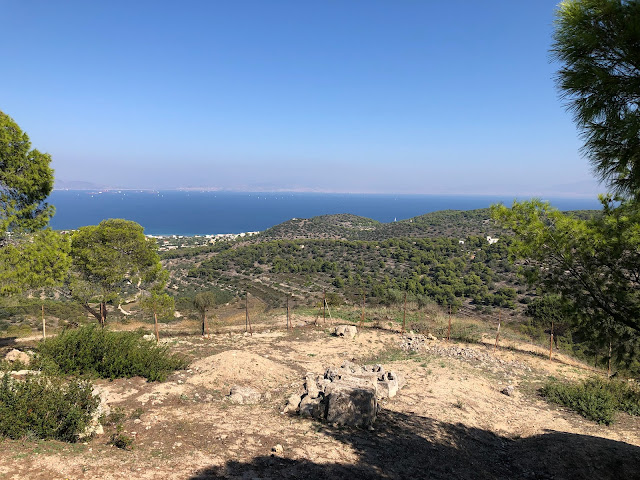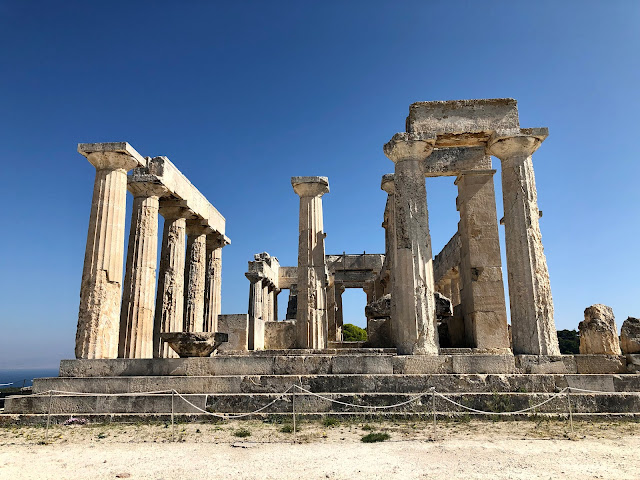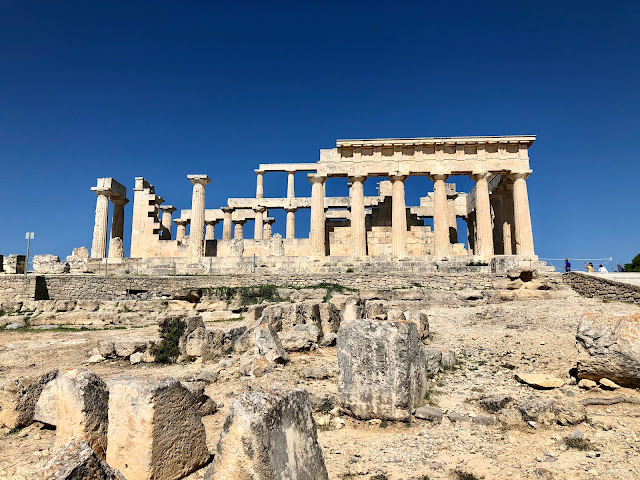There are places in this world that I have spent a lot of time searching the internet trying to figure out the best way to visit for the first time. Not too many places but there are a few that I've come back to again and again. I've definitely game planned Turkey, Easter Island, Southeast Asia, some islands in the Caribbean and maybe one or two other spots ad nauseum. Greece would definitely be on that list. Now, it's no longer on the list because I just got back from there in October of this year.
For my what-if scenario planning for Greece, my debate was always would I island hop for a week and a half between places like Crete and Santorini and Mykonos or would I spend time in Athens and do a bit less island hopping. As it turns out, neither of those scenarios happened. We ended up with four nights in Athens as the end of a week plus in Croatia. No Aegean Sea. No island-hopping.
But I felt I couldn't go to Greece and not set foot on any islands and with Athens being a port town, I figured there must be some way to get out to one relatively close to the city. I figured we'd head down to the Port of Piraeus, jump on a boat of some sort and head out for a half or three-quarters day trip and get a little taste of what I had imagined my first trip to Greece would be like.
 |
| The ferry Antigone, presumably named after the daughter of Oedipus. |
We settled on Hydra. We thought the idea of exploring a car-free island would be a cool concept. Until we checked out what there was to do on that island and decided we'd pretty much go out there, eat and come back. Hey, we're not beach people. So, we found one with some temples. Aegina. And it's about to close as Athens as you can get.
Now, I realize I already posted another blog post that detailed a visit to some temples (the Acropolis). Yes, we had to have more and spoiler alert, there's one more temple post coming. We were in Athens for four days and we visited at least one Greek temple on every day. Aegina was our last. And when I wrote this little island of just 33 or so square miles has some temples, I really mean it. There are two. On that tiny island.
Sometimes it is difficult for me to imagine a geopolitical world that is substantially different from the way it looks today. Today, Athens is the capital city of a country that also includes Aegina. But at one time (like 2,500+ years ago), Athens and Aegina were two separate entities competing with one another. I understand that there was no such country as Greece the way we know it today way back in the centuries before Christ's time. I'm also aware of the fact that Athens and Sparta and Corinth and other places that exist in modern Greece were at one time individual city-states whose people identified as Greek but as citizens of their city first and as Greek second. I just didn't imagine that a tiny island just 17 miles off the coast of Athens would support a society with its own king, its own coinage and that was a successful and flourishing sea power. These things happened back then. The world was a bigger place, I guess. Or is it smaller?
While historical records from the time of the height of Aegina's power in the region are spotty and incomplete at best, their rise to prominence as an important player in the Mediterranean seems undoubtedly related to (1) their ability to field a powerful navy; (2) the abundance of agricultural products on the island, including grains, grapes, almonds, olives, figs and particularly pistachios; and (3) their location along naval trade routes between Greece, Egypt and Asia Minor. Their crops were likely cultivated using significant amounts of slave labor. Just throwing that out there for consideration. Greek society relied heavily on slave labor.
Some of the recorded successes from Aegina are truly astounding. They were the first city-state to issue coins in Europe and they invented one of the two standards of weights and measures in existence in the Greek world. These might seem like small accomplishments but they were actually huge. Think about how essential money and a system of weights and measures were in a world where goods were the primary source of income for most everyone. Aegina was flourishing in the ancient world. Which is probably why they started building more than one temple.
 |
| One of the many, many pistachio stands in the port of Aegina. This one was pretty good. |
It's pretty easy to get to Aegina today. So easy, in fact, that we didn't book in advance, and we ALWAYS book in advance. We woke up without an alarm, left our hotel, hopped on Line 3 of the Athens Metro and got off at Piraeus. From there we found a ferry ticket office and bought a ticket on the next available ferry. About 75 minutes or so later, we were about the first people off at Aegina, meaning both the island and the town. The ferry ride is over the Saronic Gulf, by the way. No Aegean on this trip. Maybe next time.
The debarkation point of our trip from Piraeus was the port of Aegina, largest town on the island and the tourist center of everything. The harbor is this picturesque Mediterranean looking harbor with boats of every size; souvenir shops; buildings that serve the residents and visitors to the town; pistachio stands; and an enormous amount of restaurants all fronting opposite the harbor with outdoor shaded seating areas and (at least in the case of the one we picked...) the best Greek salads you've ever had in your life. Everything that happens tourist-wise on the island of Aegina likely starts in the port of Aegina.
The pistachios, by the way, are incredible. We brought a bag back home with us and they are the most delicate, most delicious and lemony nuts I've ever had in my life. I try not to have (or maybe at least try not to dwell on) regrets in life but I have to tell you, I regret not bringing more of these pistachios back home with us. They lasted over a month and I'm proud of the restraint we showed. But if I can get my hands on more of these things, I would in a heartbeat.
 |
| The Temple of Apollo's one mostly intact column. |
We laid eyes upon the first of the two temples we sought out on Aegina before we ever set foot there. As you approach the island there is a spur of land pointed towards Athens with what looks to be an obelisk fashioned out of some sort of quarried stone. It's not. It's the last surviving column of what used to be the Temple of Apollo, built sometime in the 6th century B.C.
This particular temple is not much to look at today. Its foundation is completely excavated as are the foundations and remains of surrounding buildings that together made up some sort of Acropolis. It's walkable from the port and is certainly worth the very quick walk out there. I think it took us less than 45 minutes to walk out there, walk the site, take a tour of the nearby museum and then get back to the town. There are certainly ways you can spend a lot more time out there.
For us, this was about getting a sense of the second temple on our list for the day. I think we got two things out of our very quick visit. First, you can get a lot closer to this ruin than most any other that we visited in our four days in Greece. You can actually walk on top of the base of the Temple itself. Second, when this thing was built and operational, it must have been a spectacular site on the edge of the sea facing out towards the water, welcoming travelers and traders while simultaneously showing off the wealth and might of Aegina. I've said this before (in my Acropolis post) and I'll say it again: the Greeks really knew how to locate a building on a site. It must have been glorious back in the day, before time and particularly the saltwater took its toll on the place.
But Apollo was not why we came to Aegina. We went to visit the Temple of Athena Aphaia and that would not be walkable from the port.
 |
| Looking from the back of the ruin of the Temple of Apollo to the front and the Saronic Gulf beyond. |
 |
| First view of the Temple of Athena Aphaia. |
About 15 minutes after our ferry docked, we were in a cab on the way to Athena Aphaia.
I have to say I have no idea how you would get to this site any other way than in a cab. The road to the Temple is by no means a straight line and the roads are twisty-turny most of the way. I have no idea if public transportation actually exists to take you from the port to the Temple but if it does, there's no way it's taking you on your schedule. The cab advice was good advice.
When you get to the Temple, there's a small parking area and a ticket booth and pretty much nothing else. Or at least that was the case when we got there. No other buildings, no traffic, no noise and no people. In great contrast to our visit to the Parthenon a few days earlier, there was absolutely nobody at Athena Aphaia when we arrived. Not a soul. There's nothing like getting to an ancient site and having it all to yourselves. We got there just after noon and that's the way we found it. It was pretty awesome.
It's probably been that way for a while. It is thought that the Temple was built around 500 B.C. and it's quite likely that there was not much more there then than there is now. This version of the Temple was built on top of the ruins of a prior temple, which was also built on top of some even older ruins. The whole place was built as a sanctuary so it wasn't just a temple when it was complete but it's likely whatever was built near it to support the Temple functions didn't house a ton of people.
The Temple today is approached from the parking area to the south. I have to assume the approach in ancient times was the same, otherwise there would be a very steep climb to reach the place from...well, pretty much the sea. The front of the Temple is pointed out towards the gorgeous green-blue of the Saronic Sea and pretty much totally indifferent to the approach of the visitor. Your view of both the Temple front and the water is continually denied until you reach the top of the hill and can all of a sudden see both. Of course, the water is the most enticing and draws the eye immediately, delaying your frontal view of the building.
Every Greek temple I have described on this blog from this trip is the same story. The relationship to the site and to the procession to the temple itself teases and reveals in the same sort of way. It's simple but brilliant. The Parthenon. The Erichtheion. Athena Nike. Apollo on Aegina. Athena Aphaia. All of them the same. It's like they really knew what they were doing. And yes, I know I already said that in this post.
 |
| Side view of the Temple, with assorted building parts in the foreground (top); the view from the hill (bottom). |
30 minutes. That's what we had at Athena Aphaia. I think the time was the right amount. There's not a ton to see, and 30 minutes allowed for the proper reflection about the history of the place and how gorgeous the place is today. And I know I already bragged about the lack of other people while we were there but we did just miss a tour bus that just pulled into the parking area and dumped its human contents onto the Temple grounds right as we were leaving.
 |
| View of some of the inner structure of the Temple of Athena Aphaia. |
On Aegina, Athena Aphaia was the thing.
 |
| The Monastery of Agios Nectarios. |
Our trip over to Aegina took us about 75 minutes. I know I already mentioned that. Our trip back to Piraeus lasted a bit more than half that time. On our trip to the island, we noticed a much faster ferry catching and then passing us and we decided right there and then that we'd rather take that one back, even if there was a bit of an extra cost (there was...the ferry there cost 12 Euros each; we paid an extra 7 Euros each coming back). I have to say that the quick trip back was welcomed after a hot day roaming around some temples, particularly the Temple of Apollo in the early afternoon Greece sun.
But sometimes, it pays to take the slow route. I'm glad we didn't know about the high-speed ferry on the way out there because we probably would have taken it both ways. But here's the thing: you can stand on the outside decks on the slow boat; you can't on the high-speed boat. And sometimes standing outside on the deck of a boat gets you a little bonus (I know...I've already covered a bonus for this post but there were actually two). This may seem stupid but our (second) little bonus here involved a half-dozen or so gulls.
Gulls...if there were a type of bird I'd totally be up for skipping watching at all, it would be these birds. I see little value in these things, particularly the really, really common herring gull that seems to be virtually everywhere every time we spend any time at the ocean or sea. Not interested in checking these things out really at all.
Except on this ride to Aegina. We first noticed one or two of them vying for control of the top of the mast on the front of the boat. They must have wanted a free ride on a spot where they could see a lot. I don't know. Eventually, we noticed maybe six or seven more trailing alongside the boat and then dive all at once down to the water. So we looked overboard and noticed tiny little fish jumping out of the water in the frothy churn caused by our ferry and these gulls were diving down and plucking them out of the air. Not fishing. Just skimming the sea and gobbling up those fish that were unlucky enough to decide to exit the water.
I am sure this happens all the time. Probably every day. But we had never seen it. And we wouldn't have seen it at all without taking the slow boat. Sometimes it pays to take the slow boat.
 |
| Herring gulls fishing. |





No comments:
Post a Comment